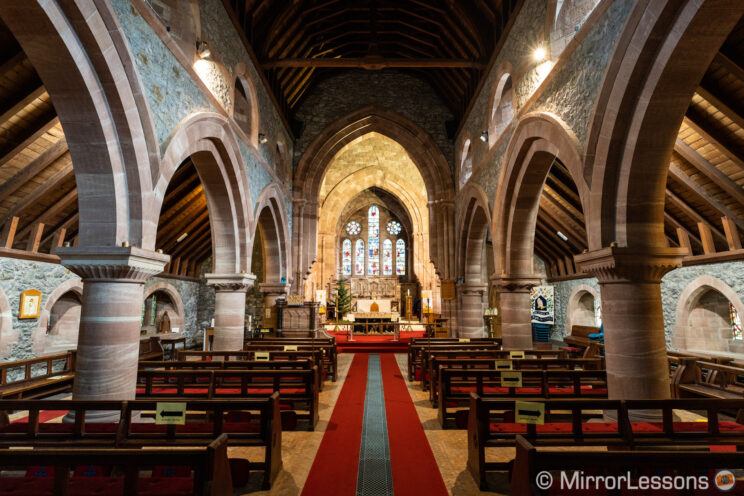Sony is expanding its v-logger line-up by adding a fourth ZV camera, the E1, the first with a full frame sensor. It inherits some great specifications from high-end models such as the A7S III and A7R V, while also offering new intelligent modes that aim to simplify the interface and settings for beginners.
The A7 IV is a popular all-rounder camera capable of delivering great image quality and fast performance for stills and video. These two products are not really in the same category but they have a similar price, so I’m sure many are wondering which model is best for their needs. Hopefully, this article will help you answer just that.
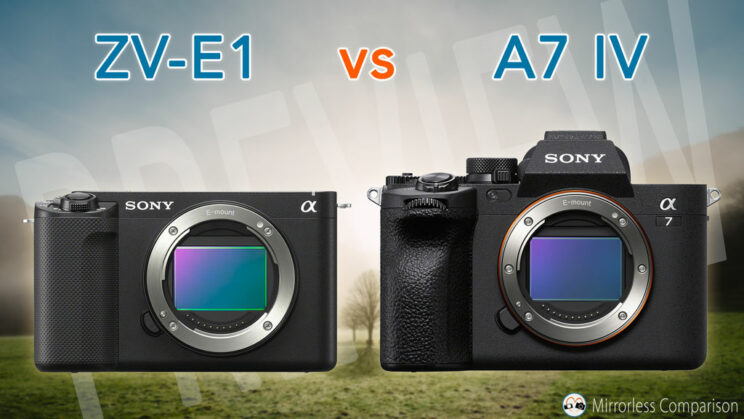
ZV-E1 vs A7 IV
ZV-E1 vs A7S III
Ethics statement: the following is based on official information for the ZV-E1 and our personal experience with the A7 IV. We were not asked to write anything about this product, nor were we provided any compensation of any kind. Within the article, there are affiliate links. If you buy something after clicking one of these links, we will receive a small commission. To know more about our ethics, you can visit our full disclosure page. Thank you!
1. Image Sensor
The ZV-E1 uses a 12MP sensor, the same found in the A7S III and FX3. Technically, it is 48MP: the sensor is built with a Quad Bayer design: instead of single blue, green and red pixels distributed across the surface, there are groups of 4 RGB pixels. These groups of 4 are then binned to 1 when reading the sensor, giving an effective resolution of 12 megapixel.
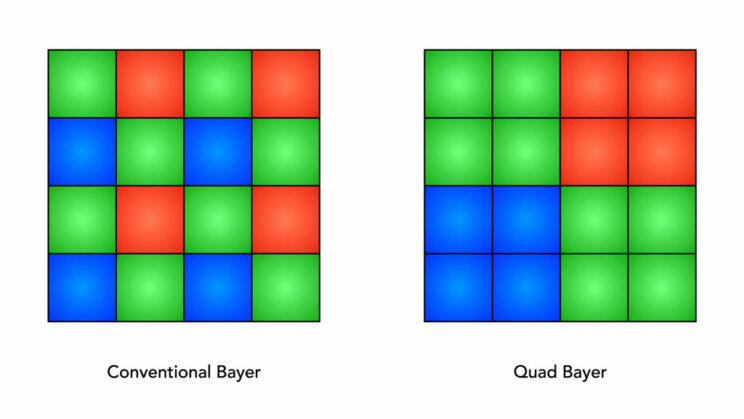
The A7 IV has a more traditional Bayer pixel array, with a resolution of 33MP. Both are full frame cameras (35mm format) and use a sensor with a back-illuminated design.
The ISO values are different, with the ZV model sporting a wider range.
ISO
Normal range
Extended range
ZV-E1
80 – 102,400
40 – 409,600
A7 IV
100 – 51,200
50 – 204,800
Note that in video mode, the low extended value of 40 and 50 respectively is not available. The maximum range for the A7 IV is 102,400 ISO.
2. Video Capabilities
The two Sony models can record high quality 4K UHD video, but there are important differences to be aware of.
The ZV-E1 can work in 4K up to 60p with no sensor crop. The A7 IV uses the entire width up to 30p but, if you want 60p, you need to activate the Super35 mode (APS-C), which translates into a 1.5x crop.
Because of the larger effective pixel count, the A7 IV records 4K 30p from a 7K region, and then downscale to 4K. On the ZV-E1, the number of pixels is just enough for 4K UHD (4.2K region to be exact). The latter is important to remember for the third chapter below.
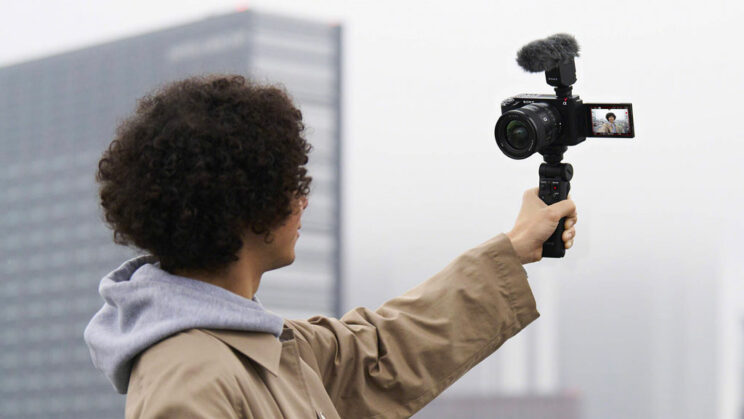
In Full HD, they both reach 120p. Note that you will have the chance to upgrade the ZV camera in the future (June 2023) and get 4K 120p and 1080/240p. This will be available via the new Creator’s Cloud platform, where you’ll be able to download a free license to install in the camera. More information can be found on the Sony website.
The recording options for both cameras include a selection of 10-bit 4:2:2, 10-bit 4:2:0 and 8-bit 4:2:0 capture, with All-Intra and LongGOP compression. You’ll find the advanced Picture Profiles with HLG, S-Log2, S-Log3 and S-Cinetone. The ZV model also allows you to add your own LUTs (look-up tables) in the settings.
Neither camera has a recording limitation per clip, but keep in mind the ZV-E1 is a smaller camera and doesn’t include the heat dissipation structure found on the mark IV model. This means it may overheat faster than the A7 IV in warm temperatures.
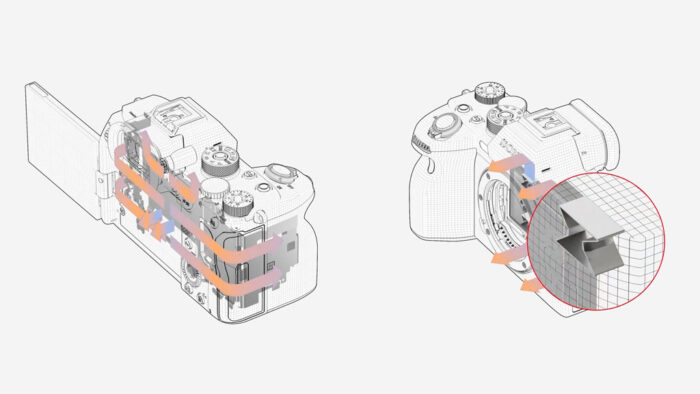
Finally, both products come with the Breathing Compensation option, which corrects the small change in field of view when going from a short to long focus distance. It only works with select lenses, and you can find the list on the Sony website.
3. Self and AI Modes for Video
The ZV-E1 has been designed for solo operators and V-Loggers. It includes a series of intelligent modes that appear for the first time on a Sony E-mount camera, and whose aim is to make the set-up easier for beginners, and allow for a few effects that would normally require a second operator behind the camera.
First of all, the E1 has a dedicated AI processing chip, a novelty the company first introduced on the high-end A7R V. It enhances the subject recognition capabilities for the autofocus, among other things.
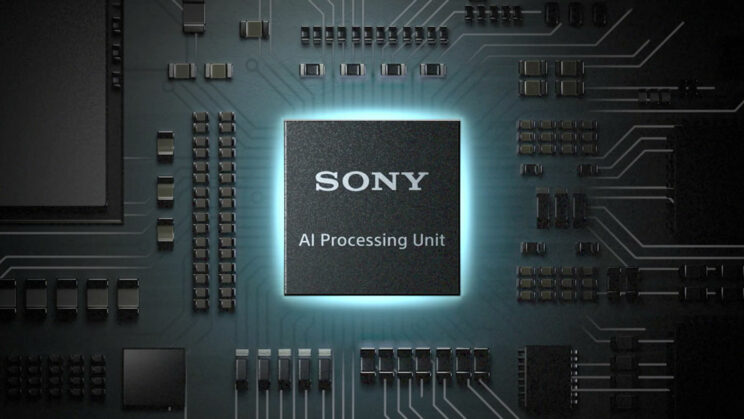
For example, the camera can automatically (and progressively) adjust the aperture to ensure enough depth of field when a second person enters the frame (otherwise, with a fast aperture, the first person is in focus and the second blurred, if they are not at the exact same distance from the camera).
Another interesting new mode is called Auto Framing: it is designed to follow the person when he or she moves in the frame. This works by cropping the sensor (three levels available) and adjusting the composition automatically to keep the presenter at the centre. DPreview TV shows how it works from minute 7:27.

Note: I said before that the ZV-E1 records 4K from a region of 4.2K. This means that when the camera crops the sensor to achieve some of these advanced effects, it records a lower resolution, and then upscales the footage to 4K. Depending on how severe the crop is, the footage may be less sharp as a result.
The microphone found on top has three capsules and their reception can be set manually (front, rear) or automatically. With the latter, they will automatically adjust depending on whether a person is talking behind the camera, or in front of the camera.
Then we have the Product Showcase mode (already available on other ZV models), where the autofocus point automatically changes to the foregound when a person puts an object in front of them. The AF goes back to the face when the object is no longer in the foreground.
There are other auto functions that, while not AI based, are only found on the ZV-E1. We have the My Image Style, which allows you to adjust image settings with simpler terms via the touch screen (for example white balance is called “color”, exposure compensation is named “brightness”).

The CineVlog mode automatically switches to 24p and adds black bars on top and bottom to mimic the 2.35:1 “cinematic” widescreen aspect ratio (basically an UHD 4K file with black bars). It selects the S-Cinetone profile, to which you can add a series of looks to change the colour and contrast of your image in a simpler way.
4. Mechanical Shutter
If you hadn’t already guessed, the ZV-E1 is very video oriented, so much so that Sony has gotten rid of the mechanical shutter.
The camera can still capture photos, but only with the electronic shutter. The maximum drive speed is 10fps, like the A7 IV, but not having the mechanical curtains like the A7 model brings some limitations:
- you can’t avoid rolling shutter or banding
- the flash sync speed is slower (1/30s vs 1/250s in full frame mode)
5. Autofocus
Both cameras feature a hybrid autofocus system with 759 phase and 425 contrast detection points.
They feature real-time tracking, which uses deep learning technology, and they both sport subject detection capabilities, but the ZV-E1 is more advanced. Thanks to the updated algorithm and dedicated AI chip, it can recognise humans and detect the face, eyes, head and body of a person. The A7 IV only detects the face and eyes.
The number of different subjects that can be detected is greater on the ZV model: while both can recognise animals and birds, in addition to humans of course, the E1 can also “see” insects, cars, trains and airplanes.
Another advantage of the ZV-E1 is the greater sensitivity in low light, with a rating of -6EV versus -4EV on the A7 IV (measured with a F2 lens).
6. Electronic Stabilisation
The two cameras have 5-axis in-body image stabilisation, with a rating of 5 stops of compensation (CIPA). In my experience with the A7 IV for still photos, decent results hand-held around 1/2s are possible, but the chances are higher when using shutter speeds of 1/8s, or faster.
For video, the performance is not great when using the standard mode. With the active mode (digital stabilisation), which crops the sensor by 1.1x, the results improve when moving (walking for example), but less so with static shots.
The ZV-E1 introduces a second digital stabilisation setting, called Dynamic Active. The crop is more severe but the stabilisation is said to be more effective (Sony says 30% better than the normal Active mode). if you’re filming yourself, holding the camera in your hand, you’ll need a super wide lens to frame yourself properly. You also have the option to adjust the framing and composition to keep the subject at the centre, using once again subject detection and AI capabilities.
Another feature, found on both cameras, is the option to use the Sony Catalyst software in post. The two products record stabilisation and rotation data in the files so that the desktop app can stabilise with better precision. It works really well, especially when moving with the camera.
7. Viewfinder
One important thing to understand is that the ZV-E1 has no viewfinder, just the rear LCD screen.
On the A7 IV, you will find a good electronic viewfinder with the following specificatioons:
- 0.5-in OLED panel with 3.69M dots
- 0.78x magnification
- 60/120Hz
- 23mm eyepoint
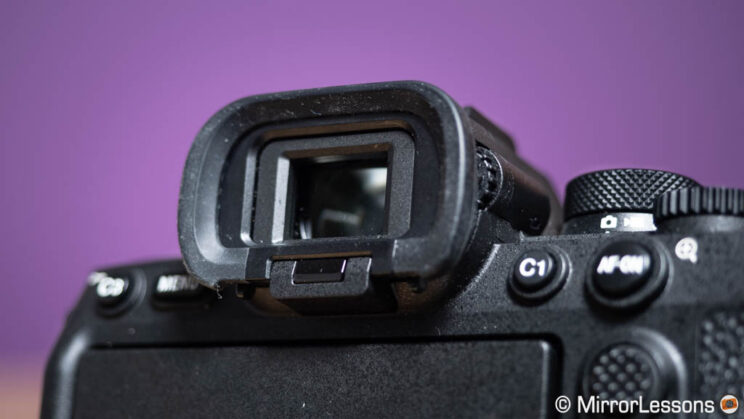
As for the rear monitor, they both have the multi-angle mechanism and the same poor resolution of 1.04M dots. The ZV-E1 has more options when it comes to gestures for the touch screen.
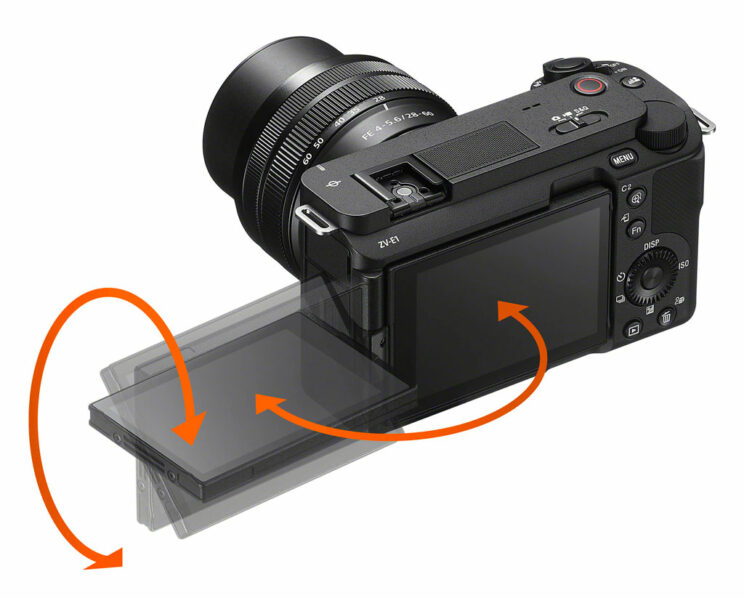
8. Design
The ZV-E1 is clearly smaller and lighter, and reminds me of the A6000 series (minus the viewfinder). The A7 IV is wider, taller, thicker, and has a more pronounced grip.
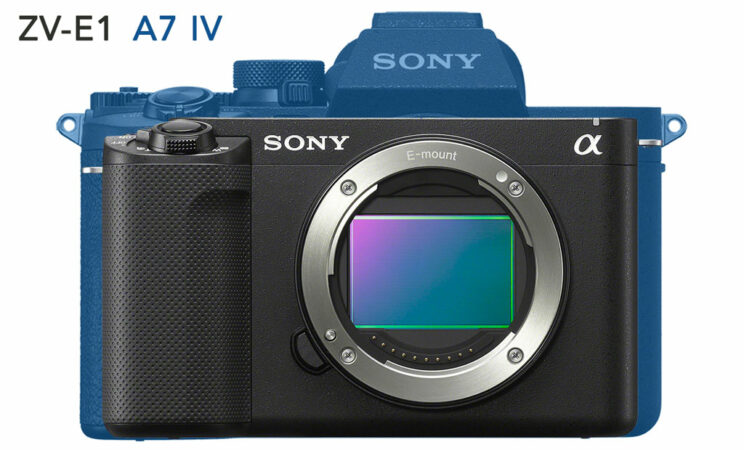
- ZV-E1: 121.0 x 71.9 x 54.3 mm, 483g
- A7 IV: 131.3 x 96.4 x 79.8mm, 658g
Both cameras are dust and moisture resistant, but only the V-log camera is available in white. I also suspect the A7 IV is more solid because of the use of a magnesium alloy chassis, as well as additional screws on the mount (six versus four).
The A7 IV offers more controls, including one extra dial to control manual exposure, an AF joystick on the rear, a main shooting mode dial on top, and extra custom buttons. The E1 model has a handy tally lamp at the front, which blinks when recording video.
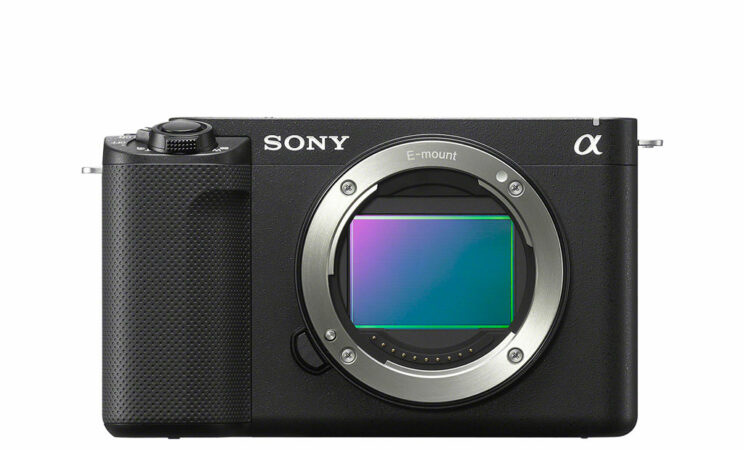
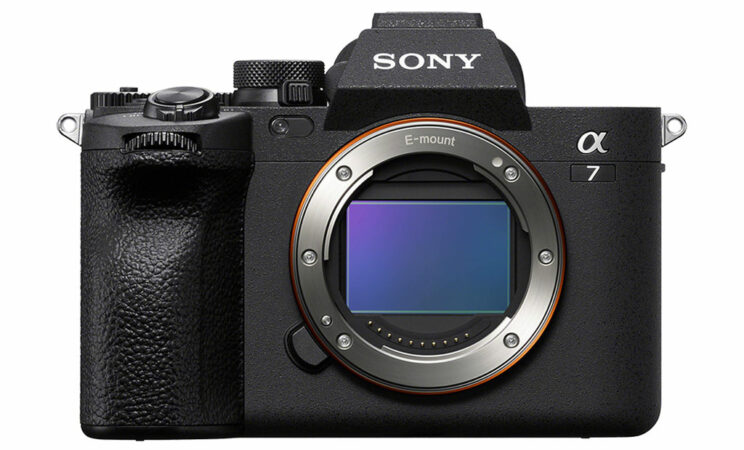
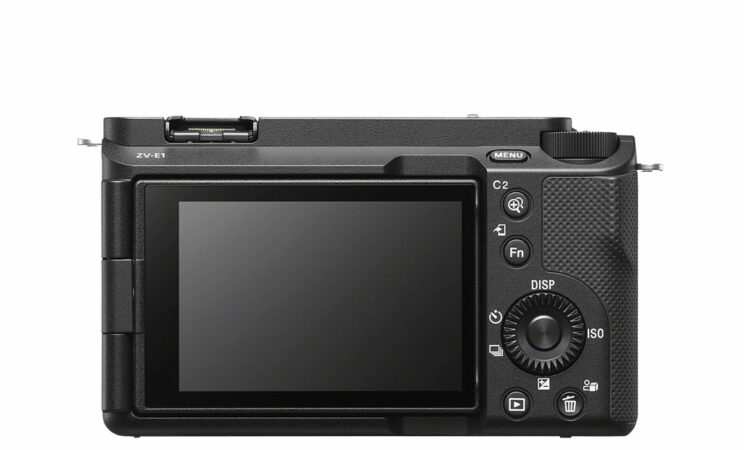
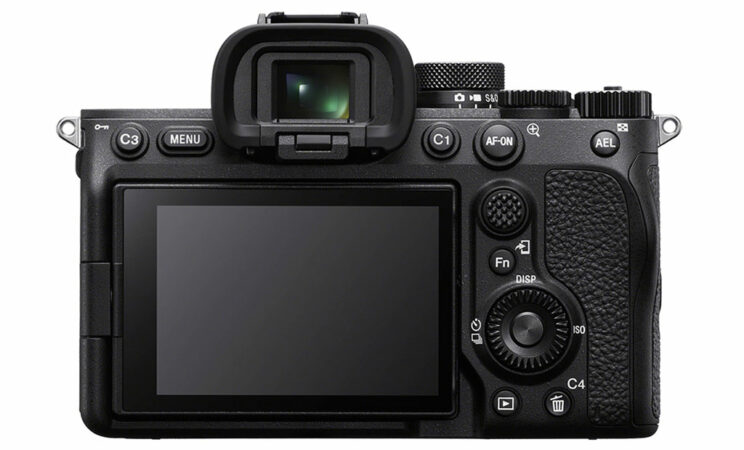
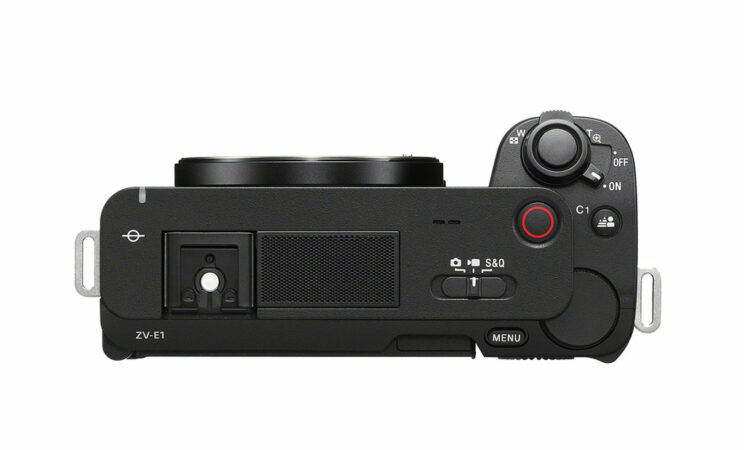
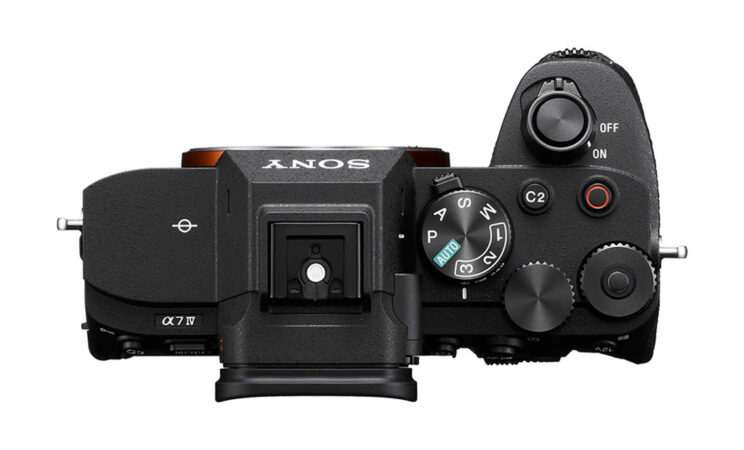
In terms of physical connections, the A7 IV has a full sized HDMI port, versus the smaller Micro HDMI type found on the ZV model. Both have a microphone input, headphone output, and the multi-interface shoe (with digital audio)
There is a USB C port, but that of the A7 IV works at 10Gbps, whereas the one on the ZV model goes up to 5Gbps. The USB port can be used to charge the battery, power the cameras, transfer files as well as stream video and audio (effectively acting like a webcam).
Finally, the two cameras use the same battery, the NP-FZ100, and have a similar CIPA rating of around 600 frames per charge (when using the LCD). The A7 IV should be able to record more video footage, according to the official specs: 110 min vs 95 min (actual recording), or 175 min vs 110 min (continuous recording).
9. Memory Cards
The ZV-E1 accepts only one SD card (UHS-II). Thankfully, it has a dedicated compartment on the side, rather than having to insert the card into the battery compartment.
The A7 IV can take two SD UHS-II cards, and slot #1 is also compatible with CFexpress Type A cards, which offer faster writing and reading speeds.
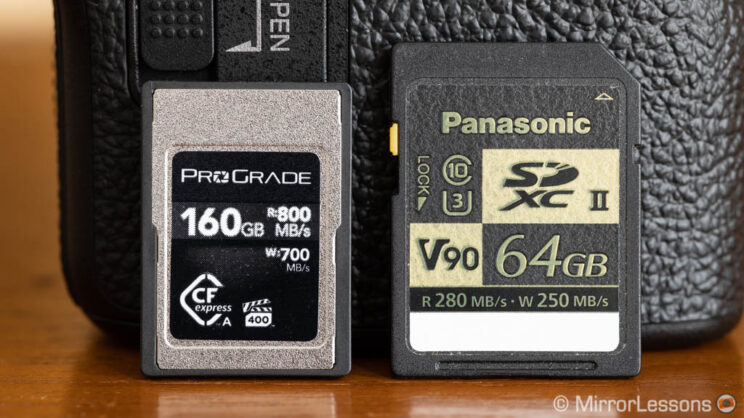
10. Price
The ZV-E1 is being launched with a retail price of $2200, £2,350 or €2,700.
The A7 IV is more expensive in the US, but has a similar price in Europe: $2500, £2400 or €2750.
Prices are as of late March 2023, for the body only.

ZV-E1 vs A7 IV
ZV-E1 vs A7S III
Conclusion
These two cameras are designed for different markets, but they share a similar price and there is some overlap depending on what you are looking for.
If you’re interested in photography, there is no question about it: the A7 IV is the better choice. It has a viewfinder, two card slots, a mechanical shutter and more physical controls. I also think it is the best choice if you’re seeking a hybrid solution, because it doesn’t compromise on the photography part while offering excellent video quality with lots of pro settings and better heat management for long recording sessions.
If you’re only interested in video, I can see why the ZV-E1 is an attractive proposition for a number of reasons: it offers a faster frame rate in 4K (up to 120p with a future update), has the same excellent sensor as the A7S III and comes with a plethora of automatic and semi-automatic modes designed for those of you just starting out. The fact that it also has Sony’s latest state of the art autofocus system is a nice plus!
Check price of the Sony ZV-E1 on
B&H Photo
Check price of the Sony A7 IV on
Amazon | Amazon UK | B&H Photo | eBay


